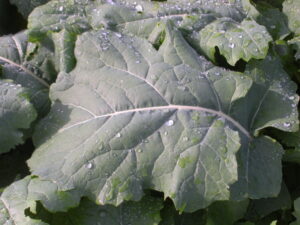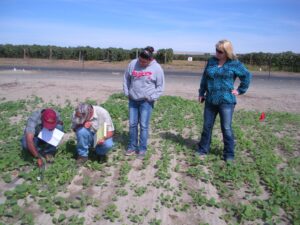Project Overview
Annual Reports
Commodities
- Agronomic: barley, canola, corn, rapeseed, wheat, hay
Practices
- Animal Production: feed rations, feed/forage
- Crop Production: cover crops, double cropping, multiple cropping, nutrient cycling, organic fertilizers
- Education and Training: decision support system, demonstration, extension, farmer to farmer, focus group, on-farm/ranch research, participatory research, workshop
- Energy: bioenergy and biofuels
- Farm Business Management: budgets/cost and returns
- Natural Resources/Environment: carbon sequestration
- Pest Management: competition, smother crops
- Production Systems: holistic management, integrated crop and livestock systems
- Soil Management: soil analysis, nutrient mineralization, soil quality/health
- Sustainable Communities: sustainability measures
Abstract:
 Winter canola grown at Ted Durfey farms near Sunnyside, WA. This was taken just before the October harvest for the dual-purpose system evaluated for winter canola.
Winter canola grown at Ted Durfey farms near Sunnyside, WA. This was taken just before the October harvest for the dual-purpose system evaluated for winter canola.
This project is aimed at evaluating, in the Northwestern United States region, the agro-environmental potential of intensive sustainable farming practices while diversifying crop rotations in the PNW region. Crop rotations were based on initial comparison of spring pea vs fallow followed by winter canola comparing single and dual-purpose canola, with winter wheat completing a single cycle. Two cycles were grown under irrigation in Montana and Washington. In Montana the on-farm study was grown rain-fed near Havre while the irrigated studies were grown on-station at the Northern Agriculture Research Center (NARC) at Havre and at the Western Triangle Agriculture Research Center (WTARC) at Conrad. The on-farm study in Montana was hosted by collaborating producer Jeff Hockett. Mr. Hockett’s was grown rain-fed about four miles from the NARC near Havre. In Washington, both the on-station study at the Irrigated Agriculture Research and Extension Center (IAREC) at Prosser and on-farm study with Ted Durfey at Natural Selection Farms, about 20 miles from Prosser, hosting and collaborating, were both grown under irrigation. In Idaho at the Parma Research and Extension Center, the project was initiated but due to planting restrictions imposed on the majority of southern and central Idaho for canola due to concerns of cross-pollination with the mustard seed industry (a widely grown high-value crop in the area), the decision has been made to switch from canola to mustard in Idaho. Field implementation of the project in the state of Oregon was scheduled to start in the spring 2016. The design and concept of this project was very innovative from the original PI, Dr. Kefyalew (Kefy) Desta when he was associated with Washington State University at Prosser. Dr. Desta relocated to Montana State University at Havre NARC in 2014/2015 with Dr. Roper, Director of Western SARE at the time, permitting the transfer of this project from WSU to MSU.
The first team meeting was hosted at IAREC at Prosser on September 8, 2015. All team members except for one from Oregon State University at Pendleton, OR, were in attendance. Dr. Desta led a fulfilling discussion of the project and his visions. Then Kefy informed team members he was leaving MSU for other opportunities but had a decided on replacement PI, Dr. Roger Ondoua from MSU at the WTARC from Conrad. Dr. Ondoua took the PI role and the next team meeting was also hosted at IAREC in Prosser on March 22, 2016. The project was approaching the halfway point in cycle 1 with cycle 2 initiated the following month. Dr. Ondoua left MSU in 2017 and was no longer PI on this project. Dr. Darrin Boss from NARC at Havre became the new PI. At the next face-to-face team meeting, held at IAREC at Prosser on March 16, 2017 with only a few members present Dr. Boss asked Dr. Steve Fransen to become a Co-PI on the project, which he accepted. The final team meeting was by conference call on March 20, 2018 to discuss development of the final report.
The project has been progressing through the different sustainable cropping rotations since its inception. The questions asked by the initial project team members were insightful and focused on investigating a new sustainable, biennial canola cropping system rotation for the PNW. There has been a large change in project team members with several current team members were not part of the original submitted and funded project. These new PIs do however think the project was of value, the objectives were ambitious and with a strong design and incorporation of such a research project on-farm is very challenging. The good news many of the original objectives can be addressed, some objectives were eliminated after team discussions, and some objective may never be answered. The educational benefit potentials are untapped but will require time for acceptance and adoption into sustainable modern agro-ecosystem canola rotation management.
Detailed results will be discussed within appropriate sections of this final report. The same experimental design was used in the three states, MT, WA and ID. Oregon decided not to participate in the project. For locations the same plot plan was used following a 2 X 2 X 7 factorial arrangement of treatments with four replications. The main factor were cropping system comparison of spring peas vs fallow, the second factor was winter canola planted following peas or fallow for single (grain only or biofuel) and dual purpose as fall grazed or simulated grazing of forage followed by grain for biofuel. The final factor were organic and inorganic soil fertility treatments. Using the correct expected mean squares the denominator was determined to test specific main or factor effects or interactions. Winter canola has not been a traditional grain or forage crop in Montana. In WA and ID winter canola is widely grown on thousands of rain-fed acres annually but only for the single purpose of grain for oil or biofuel. Expanding winter canola into the irrigated region and determining the dual-purpose potential of biennial winter canola could provide badly needed grazeable forage when pasture resources are normally depleted, plus providing essential grain for human oil consumption or energy for biofuel. The final phase of the production rotation cycle is winter wheat following winter canola grain harvest, using a wheat variety adapted to each of the three different locations, to act as a catch crop measuring soil nutrient balance compared to the initial soil samples through the multi-crop rotation over each production cycle.
Researchers in Montana hosted two field days during the course of this project where this study was highlighted and shown to area producers. From all indications there is interest among the farming community but a wait-and-see attitude likely best describes the response from many cautious ag producers when introducing new concepts and challenging long-held traditional values. Overall results suggest differences were often found when peas were grown as a nitrogen fixing cover crop compared to fallow and these differences were often prolonged through canola production but then lost by the end of the cycle. Some locations did find differences in canola grain production comparing single and dual-purpose management but these differences were often very small. Thus, the opportunity for incorporating the dual-purpose management may provide new opportunities to growers in Montana and Washington when raising winter canola for grain oil only. The following figures and tables are shared from results from the locations within the three states where this project was conducted. These provide a visual summary of various activities conducted as the project progressed since 2014 to date in 2018. As mentioned previously, the project was massive and complex and continues today until the final phase of cycle 2 is completed. The focus of this final report is devoted to the title of the project Sustainable Cropping Systems for Dual-Purpose Biennial Canola adaption and response to pea vs fallow before growing the crop and response to utilization as forage and nutrient treatment responses. 
First team meeting on September 8, 2015 at Prosser, WA. Dr. Kefy Desta (with red cap) lead the discussion. Dr; Olga Walsh is standing on the right.
Project objectives:
Quantify the fertilizer nitrogen requirements of biennial canola/mustard under the double-cropping scenarios using organic and inorganic fertilizer sources.
Quantify the nitrogen contribution of green pea to the succeeding dual-purpose biennial canola/mustard and winter wheat.
Assess the forage, silage, and hay quality of the canola grown after a fallow or a green pea crop.
Assess oil quality of biennial canola double-cropped with peas.
Compare the winter survival of canola under single and dual-purpose systems. This objective addresses the question of whether cutting canola in the fall affects winter survival and thus the final oil yield of the dual-purpose crop.
Conduct outreach on the studied cropping systems to increase the awareness of growers and the agricultural industry. Output: organized field days, workshops, and one-to-one meetings with target groups. Hardcopy publications, online, multimedia, and other outreach productions.